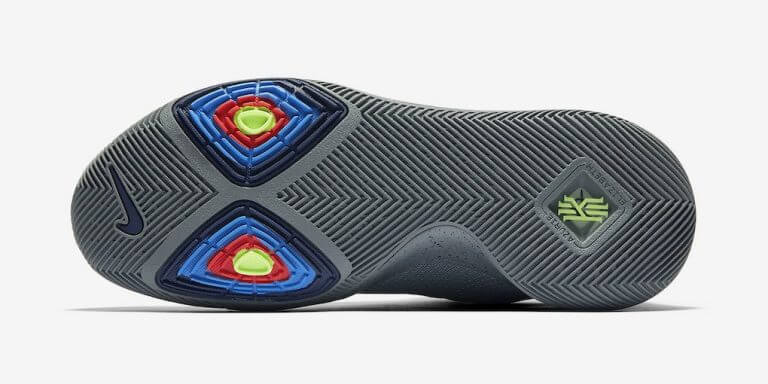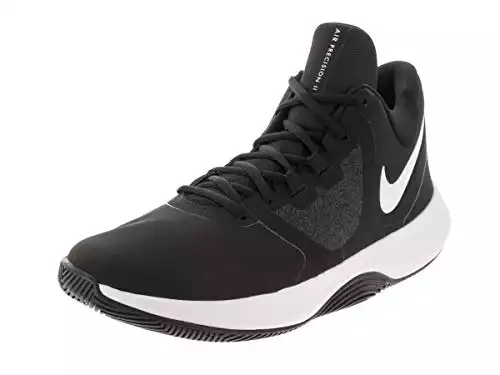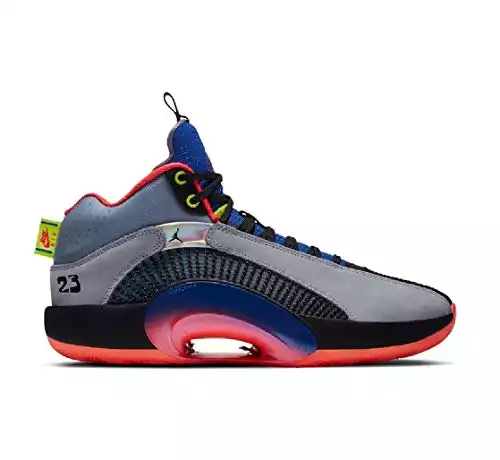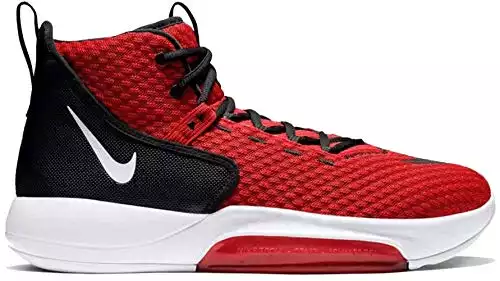Some links in this article are affiliate links, which means I earn from qualifying purchases.
What makes a great pair of weightlifting shoes?
This is a question that prompted many lifters worldwide to experiment with a wide range of shoes.
Today’s topic revolves around basketball shoes, and whether they are good for the most popular lifts: the squat and the deadlift.
In the case of these two exercises, the leverage you get from the shoes you wear has a crucial impact on the amount of force that you can gather.
So, are basketball shoes good for lifting? In short, basketball shoes bring some significant benefits to your lifts, in terms of stability, comfort, and ankle and heel support. On the other hand, their drawbacks are the absorption of force through the sole and the heel elevation during deadlifts.
But, as an answer to the question above, basketball shoes can be a fantastic option for some lifters, while being troublesome for others.
Let's get into all the details of basketball shoes and how they help lifting, squatting and deadlifts.
What Are Basketball Shoes?
As their name suggests, they are shoes designed for basketball. In other words, they are designed to withstand a lot of pressure on the feet from running and jumping.
They also offer support for the ankles to help basketball players better execute some maneuvers that are taxing on the joint.
This all makes sense in the case of basketball, but what about squatting and lifting? Well, in some aspects, the necessities of both players and lifters overlap.
These are going to be the benefits that we are listing here.
Conversely, there will be aspects that don’t overlap, which will make up our disadvantages.
6 Benefits Of Basketball Shoes For Lifting
The 6 benefits to using basketball shoes for lifting are:
Basketball Shoes Are Comfortable
First of all, the most obvious reason lifters choose these shoes is the enhanced comfort that they provide. During basketball games, the foot must be as comfortable as possible, to not distract the player from the mechanics of the game.
The same can be said about weightlifting.
During a squat or deadlift max lift, the last thing that you want to worry about is some petty discomfort created by your sole or some skin irritation that gets you out of the mindset.
These are objections that people usually raise when using lifting shoes, where the sole of the shoe is very tough, to facilitate the most efficient force transfer.
But efficiency doesn’t work its magic unless the lifter is all in on the exercise.
Basketball Shoes Have Ankle Support
Second of all, basketball shoes come with incredible ankle support.
During a game, a player must execute a variety of twists and turns that are sudden, rapid, and crucial to out maneuvering your opponent. Thus, the shoe must be designed to withstand a lot of pressure on this joint.
Similar to lifting?
Yes, especially in squatting and deadlifts.
According to two studies published in the British Journal of Sports Medicine, one on ankle injury during basketball, and the other on ankle injury in powerlifting, the ankle is the most vulnerable joint in both cases. The ankle has the largest chance of injury over time. So, the necessity of good ankle support is paramount.
Keeping your ankle in check will allow for a more accessible range of motion, which lets you hit the sweet spots of the exercises without risking to injure your ankle.
Of course, there are many alternatives to increasing your support through the shoes you wear, but we will get into that during the disadvantages.
Basketball Shoes Look Awesome
Since Jordan took flight in the early 90s, basketball shoes have a certain culture and collectible nature around them.
They are not only functional but great looking. From Jordans to Lebrons to Kobes, each shoe has its own type of look and unique set of features.
If you're one to consider what you wear on your feet during lifting, basketball shoes for squatting and lifting will help you achieve your goal.
Basketball Shoes Are Durable
NBA players put their shoes through the ringer on a nightly basis.
From sudden stops to pounding the floor hard for thirty seconds, their shoes take a beating. The quality and build construction needs to meet these requirements.
Whether, you're lifting one movement or multiple ones, basketball shoes will last you a long time and take anything you throw at them.
Despite the price, the durability of basketball shoes make them attractive options for lifters looking for functionality and longevity.
Basketball Shoes Have Traction
The rubber sole of the basketball shoe has great traction.
Think about the amount of steps and agility that a basketball player goes through during a game. Without traction, basketball players would be slipping everywhere on the court and unable to control their bodies.
In comes the shoe. The grip and traction of basketball shoes are comparable to lifting shoes and more than an average running shoe.
Traction are important during lifts such as the squat to increase ground coverage and help lifters feel secure.

Basketball Shoes Have Heel Support
Lastly, basketball shoes also offer fantastic heel support, necessary for keeping the balance of the players high at all times.
Believe it or not, this is one of the most popular struggles that lifters have with these exercises.
When there is too much pressure on the heel bone (which is not as tough as you may think), the lifter runs a high risk of losing balance to relieve that pressure, messing up the posture and decreasing force.
Lifting shoes aid you in this regard by elevating the heel of the shoe to shift the pressure on the center of the foot.
But basketball shoes simply take off some of the pressure from the heel by having a more elastic sole. This seems like a great solution too but brings some shortcomings further down the line.
All in all, the benefits of basketball shoes should not be underestimated. They fulfil some important needs of lifters struggling with the squat and the deadlift while keeping comfort at a high standard.
So, what are these shortcomings of basketball shoes for squatting and lifting.
3 Drawbacks Of Basketball Shoes For Lifting
The most notable cons are only three, but they have a large impact on your overall performance regardless.
The Sole Is Elastic
Firstly, the basketball shoe is designed for running and jumping, to protect the foot from impact transfer onto the knees and ankles.
Therefore, the sole is elastic and soft in most cases.
Why is this an issue? Because, as I said earlier, force in the squat and deadlift comes from the transfer of push power on the floor. Basketball shoes relieve impact, but they also chip away at the power that you are able to generate.
Would you have the same force deadlifting on a pair of cushions like when you deadlift barefoot? Most certainly not.
Basketball shoes are like that but on a smaller scale. Still, the elastic sole will take away some of the strength that you generate.
This will make your lifts less efficient than they would normally be. If you are a moderate lifter and don’t really care about peak performance all the time, this is not a reason to back off of basketball shoes.
But if you are a professional, or are always aiming to push yourself further and harder every time, you will need all the leverage that you can get. The latter category might need to reconsider the viability of these shoes.
Elevated Heel
Secondly, let’s talk about the heel elevation.
When you're using basketball shoes for squatting, an elevated heel may help some lifters to improve depth due to ankle flexibility..
However, when it comes to wearing basketball shoes for deadlifts, you want to get closer to the ground. The closer you are to the ground the better your transfer of force and energy.
The difference in heel heights among basketball shoes varies quite a lot and depends on the brand and make. If you personal preference is to have a slight heel for your deadlifts then this is not a huge issue.
Basketball Shoes Are Expensive
The build quality combined with the collectability of basketball shoes make them quite pricey for lifters.
Most basketball shoes are priced above $100 and require an investment towards your lifting career. There are alternatives to basketball shoes when it comes to lifting including wrestling shoes and even Vans shoes.
The ultimate question it comes down to is how much would you spend for functionality and the benefits of basketball shoes.
What Lifts Should You Avoid When Wearing Basketball Shoes?
Due to the cushion of basketball shoes, certain lifts should try and be avoided. Again, basketball shoes are meant to be tough and supportive.
The following exercises should not be done when wearing basketball shoes.
Who Should Wear Basketball Shoes For Lifting?
The moderate, amateur lifter is the person which goes to the gym consistently, aims for reasonable progress, but does not need to pull max lifts on every single session. For this type of person, I would recommend basketball shoes.
The additional degree of comfort, ankle and heel support may be a very fitting option for somebody in this position. Of course, there are variations based on personal preference, so my recommendation is just general advice.
On the other hand, the professional, or committed lifter is the person for which powerlifting is an essential part of his/her everyday routine. For whom progressing to heavier and heavier weights is a passion, and who loves breaking PRs in every session. For this type of person, I would not recommend basketball shoes.
While the comfort and support are nice, these people are aiming for performance above all, and for having the best chances of getting the largest lift possible. The elastic sole and hindrance of an elevated heel during deadlifts would simply not make the cut.
Best Basketball Shoes For Lifting
Now that we’ve seen what basketball shoes stand to offer and for whom, it is time to check the market for the best deals out there. As an important note, the basketball industry is pumped with expensive pairs of shoes, but it does not mean that all are like that.
In fact, you can find some pretty neat bargains if you take the time to search.
Nike Air Precision
The Nike Men’s Air Precision is the first shoe that I want to talk about. It’s on the more budget-friendly side of the spectrum, providing excellent ankle support and comfort of movement.
The texture of the shoe is designed to allow for comfort but is also elastic enough to allow your foot to move and breathe.
If you just want to test the waters on basketball shoes for lifting, this is your best bet.
Air Jordan 35
On the other side of the budget-approval index, we have the Air Jordan 35.
This is a shoe that’s being praised by basketball players worldwide for its incredible attention to foot comfort and joint protection.
The difference between this pair and the Nike shoe I mentioned earlier may be significant in basketball, but not in lifting.
Instead, this shoe is for those of us who have the money to invest in looks and who care about their gym persona. When it comes to standing out, the Jordans never fail to impress.
Nike Zoom Rize
Lastly, the Nike Zoom Rize is the last basketball shoe.
It’s a somewhat midway point between the other two, but it comes with a very important, unique feature: a flatter sole.
Of course, the elasticity and support are still there to a great degree, but the flat sole helps the lifter connect with the floor better while squatting or deadlifting.
This is a very important feat, as it plays into how much balance you have during these exercises, and how much control you have over your movements.
The other two have some significant curvature in their soles, making it harder for the lifter to correct posture naturally and improve their range of motion.
If you find yourself wanting the looks, but also needing the spare change, this option may resonate well with you.
Frequently Asked Questions
Are Basketball Shoes Good For Squatting?
Basketball shoes come with an elevated heel. The elevated heel offers great support and an ideal option for lifters. Wearing basketball shoes for squatting will help you get lower due to increased ankle range of motion. For beginners, basketball shoes for squatting will help you progress quicker and improve form.
Final Thoughts
All in all, basketball shoes are an interesting experiment in the world of lifting. They show how lifters can adapt features of one sport in the game of the other, with surprising overlaps in requirements.
Even if this article proved that basketball shoes are not your best fit, it may have brought you closer to understanding what your personal needs are, as well as the gym persona that you want to embody.
Basketball shoes for lifting and more specifically, basketball shoes for squatting are a safe and effective option. Be sure to check out the resources below for any further research.
References
Aasa U, Svartholm I, Andersson F, Berglund L. Injuries among weightlifters and powerlifters: a systematic review. Br J Sports Med. 2017 Feb;51(4):211-219. doi: 10.1136/bjsports-2016-096037. Epub 2016 Oct 4. PMID: 27707741.
McKay, G. D., Goldie, P. A., Payne, W. R., & Oakes, B. W. (2001). Ankle injuries in basketball: injury rate and risk factors. British journal of sports medicine, 35(2), 103–108. https://doi.org/10.1136/bjsm.35.2.103
DISCLAIMER: This article is for intended for educational purposes only and not as an individualized exercise prescription, therefore no one can be held liable in the occurrence of injuries, damages or monetary losses as a result of the information.








